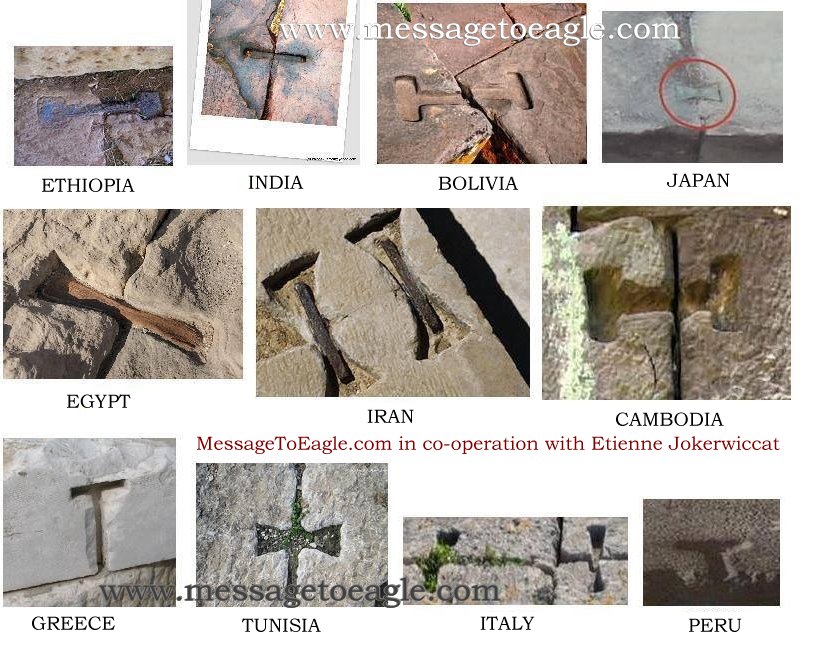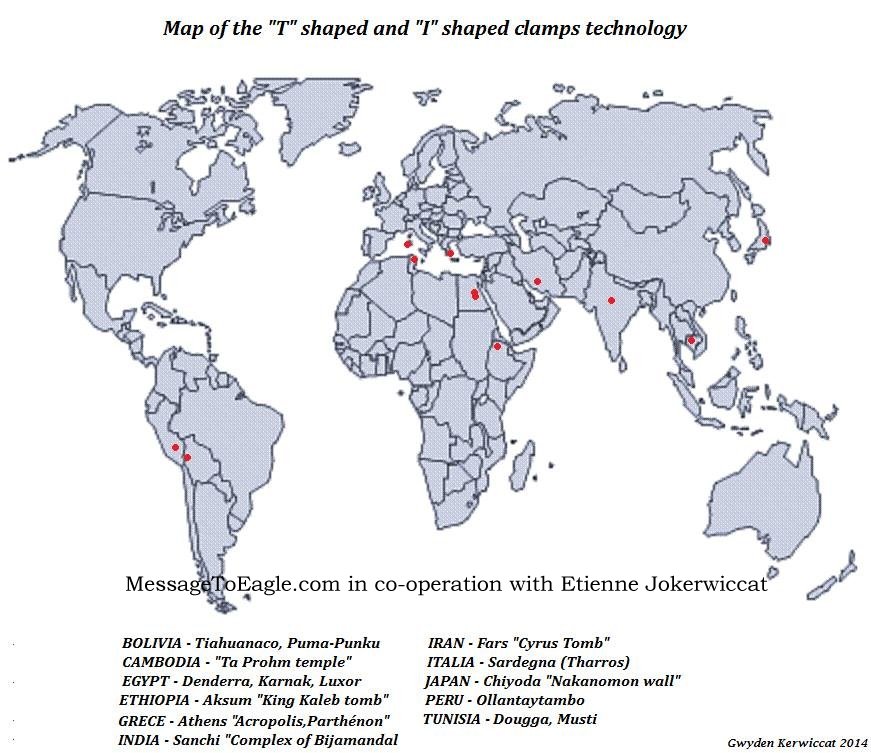Mystery Of Ancient Metal Clamps – Advanced Lost Technology Modern Science Still Cannot Explain
Ellen Lloyd – MessageToEagle.com – Ancient metal clamps discovered on megaliths, temples, and other prehistoric monuments worldwide are one of the greatest unsolved ancient mysteries of all time.
Why would the builders use or need a small metal clamp to hold large stone blocks in place?
How did this technology spread to ancient Egypt, Pre-Columbian Peru, and Cambodia thousands of years ago?
These countries are separated by thousands of miles. Who taught our ancestors how to use this technology?
The use of metal clamps in T-Grooves has been discovered in Tiahuanaco, Ollantaytambo, Koricancha, and the site of Yuroc Rumi, Vilcabamba. These clamps were also used on the Parthenon, on buildings in Mesopotamia, Egypt, and Cambodia.

Some scientists have suggested the clamps were for ceremonial use. Other researchers point out that ancient metal clamps served for keeping the blocks together, so they would harden out in the right position.
Several imprints show that metal clamps intended to join huge blocks of stone that our modern machines cannot lift.
Unfortunately, very few of the clamps have survived. The Spanish removed many clamps, thinking they might be gold. Some may indeed have been decorated with silver and gold, because it’s well-documented that armies set about demolishing these structures, just for the clamps.
The clamps from Pre-Columbian South America that have been examined show them to be made of a very unusual alloy – 2.05% arsenic, 95.15% copper, 0.26% iron, 0.84% silicon and 1.70% nickel.
This composition is particularly interesting because there is no source nickel anywhere in Bolivia. At first, archaeologists believed that clamps were brought to these grooves to be placed, but recent scans have revealed that metal was poured into these indentations, which means the builders had portable smelters.

The metals used could only be melted at very high temperatures; temperatures the ancients (to our knowledge) were not capable of. The rare alloy of nickel-bronze-arsenic requires extremely high temperatures.
 The Puma Punka brackets holes, when analyzed, showed platinum, a metal that only melts at 1753 C and aluminum, which supposedly was not discovered and produced in quantity until the 19th century.
The Puma Punka brackets holes, when analyzed, showed platinum, a metal that only melts at 1753 C and aluminum, which supposedly was not discovered and produced in quantity until the 19th century.
See also:
10 Remarkable Similarities Between Ancient Civilizations
Obviously our ancestors had access to very advanced technology that became lost in the immediate centuries afterward, a technology and means modern science still cannot explain.
NOTE: MessageToEagle.com would like to express gratitude to Etienne Jokerwiccat for sharing excellent research and photos with us. On behalf of the entire site and all its readers – thank you, Etienne!
Written by Ellen Lloyd – MessageToEagle.com
Copyright © MessageToEagle.com. All rights reserved. This material may not be published, broadcast, rewritten or redistributed in whole or part without the express written permission of MessageToEagle.com
Related Posts
-
 Do We Live In A Computer Simulation Created By An Advanced Alien Civilization?
No Comments | Sep 7, 2013
Do We Live In A Computer Simulation Created By An Advanced Alien Civilization?
No Comments | Sep 7, 2013 -
 Egyptian Blue: World’s Oldest Artificial Pigment
No Comments | Feb 6, 2016
Egyptian Blue: World’s Oldest Artificial Pigment
No Comments | Feb 6, 2016 -
 CoRoT-7b – Alien World That Contributes To The Vision Of Hell
No Comments | May 10, 2012
CoRoT-7b – Alien World That Contributes To The Vision Of Hell
No Comments | May 10, 2012 -
 Legendary Beowulf Fighting Dragon Grendel In Heroic Poem Written In Anglo-Saxon England
No Comments | Aug 16, 2022
Legendary Beowulf Fighting Dragon Grendel In Heroic Poem Written In Anglo-Saxon England
No Comments | Aug 16, 2022 -
 Seismic Echoes Reveal A Mysterious ‘Donut’ Inside Earth’s Core
No Comments | Sep 3, 2024
Seismic Echoes Reveal A Mysterious ‘Donut’ Inside Earth’s Core
No Comments | Sep 3, 2024 -
 The Iceni’s Queen Boudicca Who Revolted Against Roman Rule
No Comments | Jun 9, 2016
The Iceni’s Queen Boudicca Who Revolted Against Roman Rule
No Comments | Jun 9, 2016 -
 Time Travel And Parallel Universes: A Discussion Between A Scientist And A Literature Professor
No Comments | May 27, 2017
Time Travel And Parallel Universes: A Discussion Between A Scientist And A Literature Professor
No Comments | May 27, 2017 -
 Size Of “Small” Rosetta’s Comet Compared To Los Angeles
No Comments | Feb 6, 2017
Size Of “Small” Rosetta’s Comet Compared To Los Angeles
No Comments | Feb 6, 2017 -
 Iсеlаnd’ѕ “Troll Wаr” Pillars In Skaelinger Valley Were Formed By Lava
No Comments | Mar 21, 2016
Iсеlаnd’ѕ “Troll Wаr” Pillars In Skaelinger Valley Were Formed By Lava
No Comments | Mar 21, 2016 -
 Atomic Theory Was Invented 2,600 Years Ago By Acharya Kanad – A Genius Ahead Of His Time
No Comments | May 15, 2014
Atomic Theory Was Invented 2,600 Years Ago By Acharya Kanad – A Genius Ahead Of His Time
No Comments | May 15, 2014



